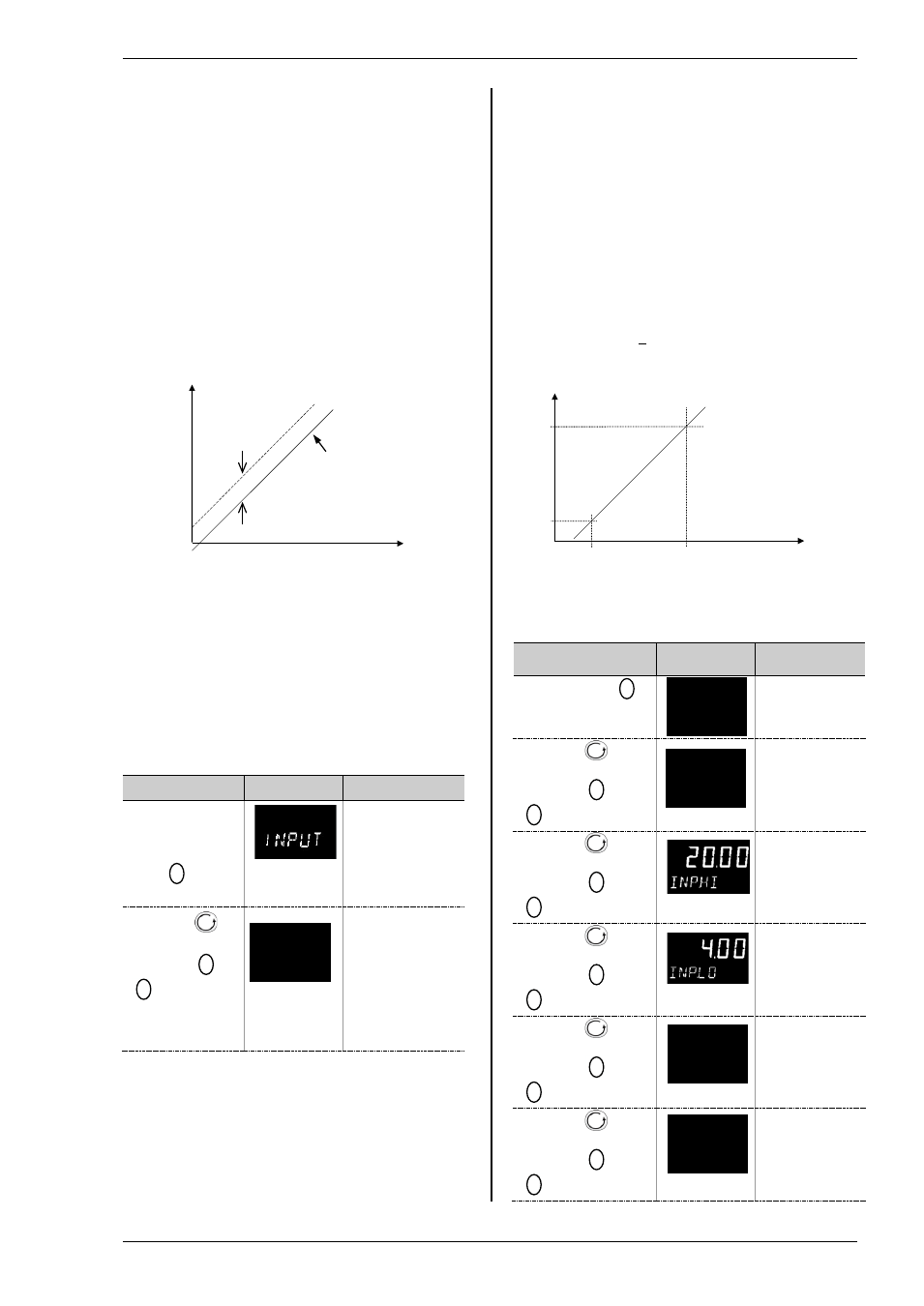3 pv offset, 1 example: to apply an offset, 4 pv input scaling – Super Systems 3L Series User Manual
Page 25: 1 example: to scale a linear input, Pv offset, Pv input scaling, On 6.1.3 for, On 6.1.3, 0 pv.ofs, Mv i n . t y p

Series 3L Indicators
25
6.1.3 PV Offset
All ranges of the indicator have been calibrated against
traceable reference standards. This means that if the
input type is changed it is not necessary to calibrate the
indicator. There may be occasions, however, when you
wish to apply an offset to the standard calibration to
take account of known errors within the process, for
example, a known sensor error or a known error due to
the positioning of the sensor. In these instances it is
not advisable to change the reference (factory)
calibration, but to apply a user defined offset.
PV Offset applies a single offset to the temperature or
process value over the full display range of the indicator
and can be adjusted in Level 3. It has the effect of
moving the curve up a down about a central point as
shown in the example below:-
6.1.3.1 Example: To Apply an Offset:-
Connect the input of the indicator to the source device
which you wish to calibrate to
Set the source to the desired calibration value
The indicator will display the current measurement of
the value
If the display is correct, the indicator is correctly
calibrated and no further action is necessary. If you
wish to offset the reading:-
Do This
Display
Additional Notes
1.
Select Level
3 or Conf as
described in
Chapter 2. Then
press
to
select ‘INPUT’
Scrolling display
‘p r o c e s s
i n p u t l i s t ’
2.
Press
to
scroll to ‘PV/OFS’
3.
Press
or
to adjust the
offset to the
reading you
require
Scrolling display
‘p v o f f s e t ’
In this case an
offset of 2.0 units
is applied
It is also possible to apply a five point offset which
adjusts both low and high points. This is done in Level
3 using the CAL List, and the procedure is described in
the Calibration section 1212.2.1.
6.1.4 PV Input Scaling
Input scaling applies to the linear mV and volts input
ranges only. This is set by configuring the INPUT
TYPE parameter to
mV or VoLt, mV has an input range
of –10 to 80mV. Using an external burden resistor of
2.49
Ω, the indicator can be made to accept 4-20mA
from a current source. Scaling of the input will match
the displayed reading to the electrical input levels from
the transducer. PV input scaling can only be adjusted
in Configuration level and is not provided for direct
thermocouple or RTD inputs.
The graph below shows an example of input scaling,
where it is required to display 2.0 when the input is 4mV
and 500.0 when the input is 20mV .
If the input exceeds +5% of the
inp.Lo or inp.Hi
settings, sensor break will be displayed.
6.1.4.1 Example: To Scale a Linear Input
Select Configuration level as described in Chapter 2.
Then:-
Do This
Display
Additional
Notes
1.
Then press
to select ‘i n p u t ’
Scrolling display
‘p r o c e s s
i n p u t l i s t ’
2.
Press
to
scroll to ‘i n . t y p ’
3.
Press
or
to ‘
mV’or VoLt
Scrolling display
‘i n p u t t y p e ’
4.
Press
to
scroll to ‘i n p . h i ’
5.
Press
or
to ’
20.00’
Scrolling display
‘l i n e a r i n p u t
h i g h ’
6.
Press
to
scroll to ‘i n p . l o ’
7.
Press
or
to ‘
4.00’
Scrolling display
‘l i n e a r i n p u t
l o w ’
8.
Press
to
scroll to ‘r n g . h i ’
9.
Press
or
to ‘
500.0’
In operator level
the indicator will
read 500.0 for a
mV input of
20.00
10. Press
to
scroll to ‘r n g . l o ’
11. Press
or
to ‘
2.0’
In operator level
the indicator will
read 2.0 for a
mV input of 4.00
i n p u t
2.0
pv.ofs
mv
i n . t y p
500.0
r h g . h i
2.0
r h g . l o
For mA inputs
4-20mA = 9.96-49.8mV with
2.49
Ω load resistor
0-20mA = 0-49.8mV with
2.49
Ω load resistor
mA input will detect sensor
break if mA < 3mA
Use a current source to
remove shunt resistor errors
i n p . l o eg
4 mV
Electrical Input
Display
Reading
R N G . H I
eg 500.0
R n g . l o
eg 2.0
i n p . h i
eg 20 mV
Electrical Input
Display
Reading
Fixed offset
(e.g. 2)
Factory
calibration
